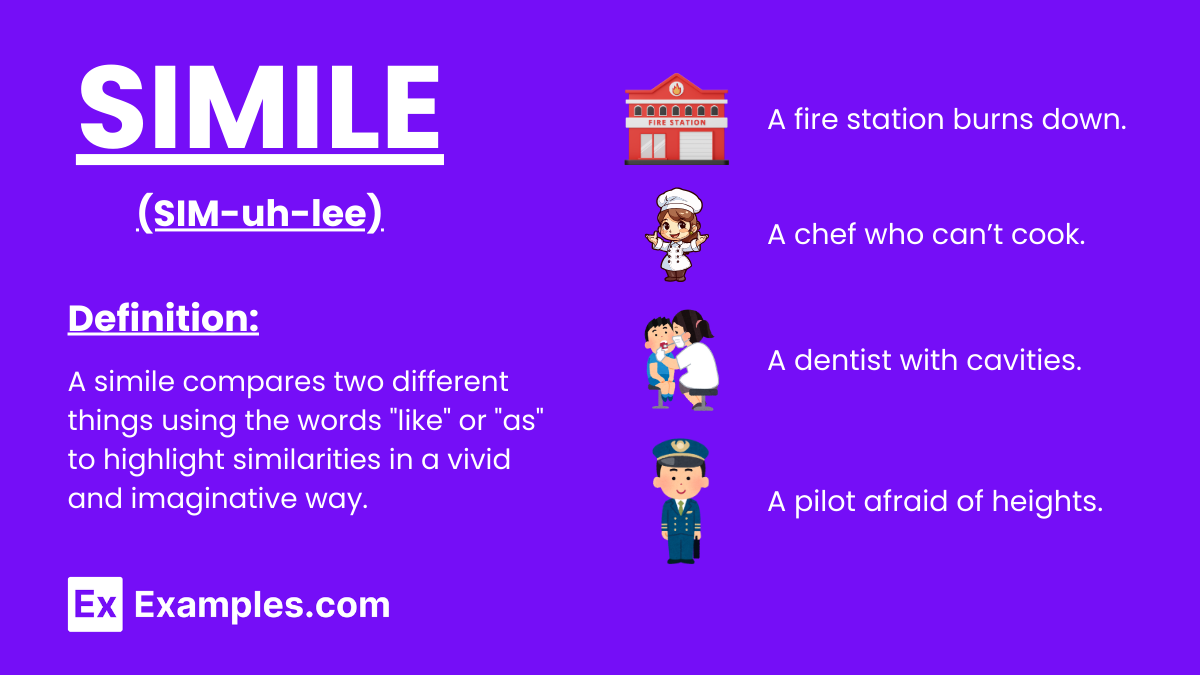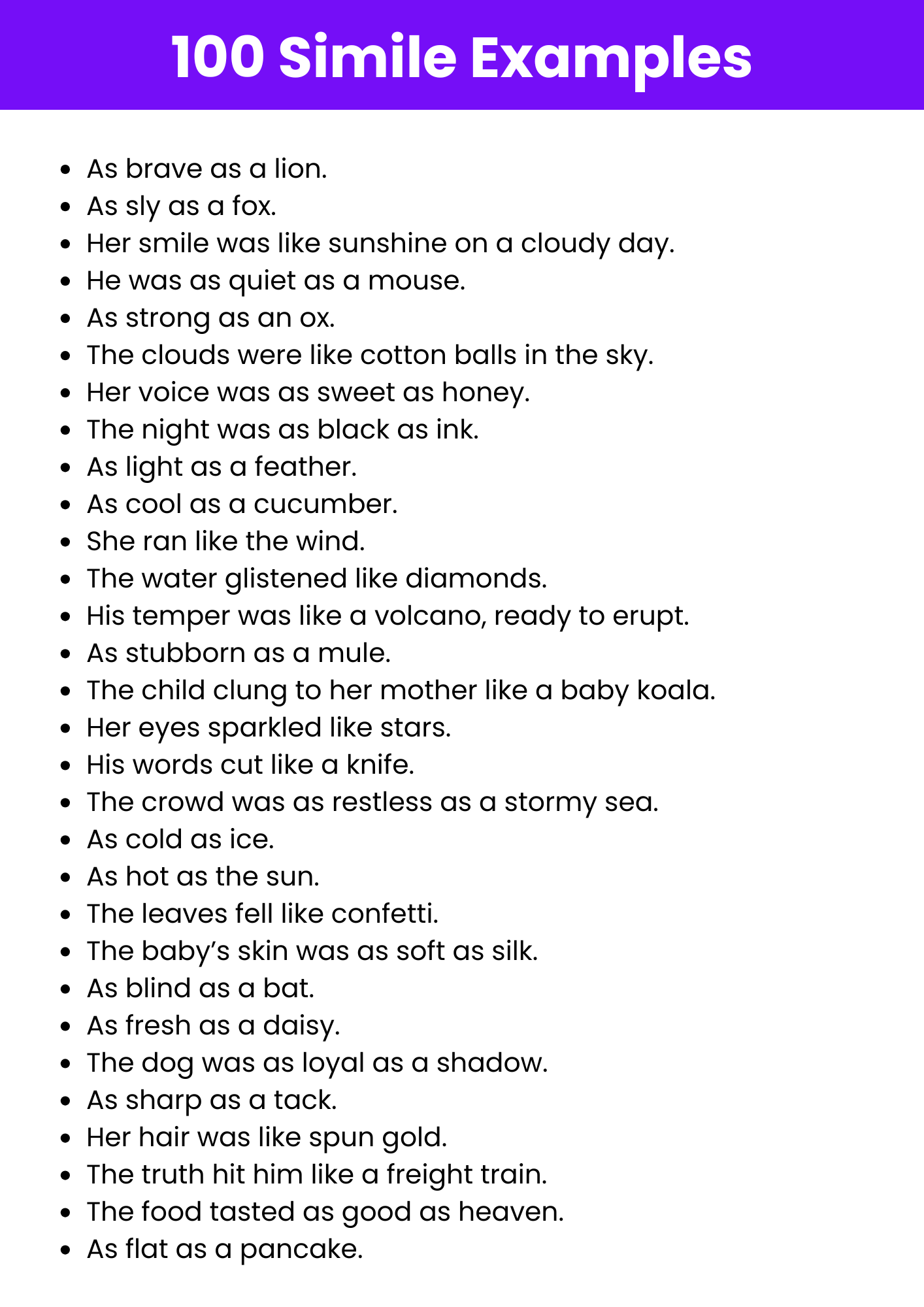Simile
What is Simile? – Definition
A simile directly compares two different things using the words “like” or “as.” It’s used to make descriptions more emphatic or vivid by highlighting similarities between the two compared elements.

Generated Simile Examples

Examples of Similes
- Her smile is like sunshine.
- He runs as fast as a cheetah.
- Her voice was as soft as a whisper.
- His heart is as cold as ice.
- She was as graceful as a swan.
- Time is like a river flowing continuously.
- The world is like a stage.
- Her voice is like music to his ears.
- He is like a wolf in sheep’s clothing.
- Life is like a rollercoaster.
- He is as brave as a lion.
- She is like a firecracker.
- His smile is like a ray of sunshine.
- Her words are like burning fire.
- He has a mind like a cloud.
- The camera is like his eye.
- The clock is like a thief stealing time.
- The mirror is like a window to the soul.
- The road ahead is like an unclear path.
- The sunset is like a beautiful end.
- His mind is like a steel trap.
- The city is like a jungle.
- The classroom is like a zoo.
- Her smile is like the sun.
- Life is like a dance.
- Life is like a journey through uncharted waters.
- She is like an anchor in the storm.
- His eyes are like windows to his soul.
- She is like a mountain of patience.
- His temper is like a lightning bolt.
Types of Similes
Comparative Similes
A straightforward comparison using “like” or “as” to highlight similarities between two different things.
- Busy as a bee.
- Brave like a lion.
- Cold as ice.
- Sweet like honey.
- Light as a feather.
Descriptive Similes
These similes are used to describe appearance, actions, or emotions in detail.
- The baby’s skin was as soft as a feather.
- Her dress shimmered like moonlight.
- His laughter echoed like a song.
- The lake was as still as glass.
- Her eyes were as bright as stars.
Emotive Similes
These express emotions by drawing comparisons to relatable scenarios.
- His heart felt as heavy as stone.
- She was as happy as a child with a new toy.
- His anger burned like a wildfire.
- Her sorrow was as deep as the ocean.
- He was as nervous as a cat in a room full of dogs.
Visual Similes
These focus on imagery and create strong visual associations.
- The sky was as red as a ripe apple.
- The clouds floated like cotton candy.
- Her hair was as black as midnight.
- The tree stood as tall as a skyscraper.
- The street shimmered like a mirage in the heat.
Behavioral Similes
These describe actions or behavior using relatable comparisons.
- He fought like a lion.
- She worked as hard as a machine.
- The kids scattered like ants.
- He danced like a puppet on strings.
- She jumped as high as a kangaroo.
Abstract Similes
These compare intangible concepts like time, life, or ideas to tangible elements.
- Life is like a winding road.
- His dreams were as fragile as glass.
- Time slipped away like sand in an hourglass.
- Her love was as constant as the moon.
- Hope shined like a beacon in the dark.
Sound Similes
These focus on sounds and how they resemble other sounds or feelings.
- Her laugh was as sweet as chimes.
- The thunder cracked like a whip.
- The wind howled like a wolf.
- His voice was as sharp as a knife.
- The music flowed like a river.
How to Identify/Find Simile?
To identify similes, look for phrases that compare two different things using “like” or “as”. Similes often highlight similarities between unrelated subjects, creating vivid imagery or enhancing descriptions.
- Look for direct comparisons using “like” or “as”.
- Identify words or phrases that create strong imagery.
- Check if the comparison enhances the understanding of the subject.
- Notice if the comparison adds emotional or descriptive depth.
- Look for similes that are integral to the theme or message.
How to Use Simile?
Use similes to enhance your writing by making comparisons that reveal new insights or add emotional depth. Ensure your similes are clear and relevant to the subject, avoiding mixed or clichéd expressions for greater impact.
- Choose comparisons that resonate with your audience.
- Use vivid and specific imagery to make your simile stand out.
- Integrate similes seamlessly into your narrative or argument.
- Ensure the simile enhances the reader’s understanding or emotional response.
- Avoid overusing similes to maintain their effectiveness.
Other Simile Examples
Similes in Daily Life
Daily life is filled with similes that help us convey our thoughts, feelings, and experiences more vividly.
- He is as strong as an ox.
- Her voice is like music to my ears.
- His words cut deeper than a knife.
- Laughter is like the best medicine.
- The world is like your oyster.
Simile Examples for Kids
Introduce children to the enchanting world of kid-friendly similes with relatable comparisons like “smile is like sunshine” or “friendship is like a warm blanket.”
- The clouds are like cotton candy.
- Her smile is like sunshine.
- The playground is like a jungle.
- His room is like a tornado.
- The stars are like diamonds in the sky.
Simile Examples for Students
Empower students with similes that make learning engaging. Discover how “studying fuels the brain’s engine” and “creativity is like a toolbox of colorful ideas.”
- Knowledge is like a light in the dark.
- The classroom is like a hive of activity.
- Books are like keys to wisdom’s treasure.
- Homework is like a mountain to climb.
- The mind is like a powerful engine.
Simile Examples in Poetry
Similes in poetry use “like” or “as” to create vivid imagery and evoke emotions.
- My love is like a red, red rose
- The clouds were like cotton balls in the sky.
- Her smile was as bright as the morning sun.
- He was as quiet as a mouse in the moonlit room.
- The rain fell like silver threads from heaven.
Simile Examples in Literature
Similes in literature enrich descriptions and make abstract ideas relatable using “like” or “as.”
- She hung her head like a dying flower.
- The night was as black as ink.
- He ran like a gazelle escaping its predator.
- Her voice was as soft as a feather falling to the ground.
- The stars shone like diamonds scattered across the sky.
Hard Simile Examples
Hard similes use unusual imagery or abstract comparisons to provoke deeper thought.
- His mind was like a locked vault, impenetrable and mysterious.
- Life is as fleeting as a candle in the wind.
- Her laughter was like shattered glass, sharp and piercing.
- The truth was as elusive as a shadow in the mist.
- Time moved like a snake through the grass, silent but ever-present.
Simile Examples About Love
Passionate and expressive similes that capture the intensity and essence of love in all its forms.
- Love is like a burning flame.
- Love is like a rollercoaster ride.
- Love is like the glue that binds us.
- Love is like a storm, wild and free.
- Love is like a garden that needs care.
Explore Other Literary Devices
Elevate Your AP English Preparation
Unlock your potential with our comprehensive AP English exam preparation tools designed to help you excel.
- Extensive Question Bank: Access 900+ exam-like questions for both AP English Language and Literature.
- Expertly Crafted: Questions mirror the structure and difficulty of actual AP exams, ensuring relevant practice.
- Detailed Explanations: Understand your mistakes with clear, concise breakdowns of correct and incorrect answers.
- Personalized Learning: Tailor your study sessions with topic-specific tests and adaptive learning tools.
- Comprehensive Coverage: Master all aspects of the AP English curriculum with extensive guides and resources.
Frequently Asked Questions
-
How is a simile different from a metaphor?
Unlike metaphors, which make a direct comparison, similes use “like” or “as” to highlight similarities between two distinct things. -
Why are similes used in writing?
Similes enhance descriptions, making writing more vivid and helping readers visualize concepts more clearly. -
Where can similes commonly be found?
Similes are frequently used in literature, poetry, everyday speech, and advertising to create impactful imagery. -
Are there different types of similes?
Yes, similes can be simple (using “like” or “as”) or extended, where the comparison continues over several lines or sentences. -
What makes a simile effective?
An effective simile creates a clear, relatable, and vivid comparison that enhances the reader’s understanding or emotional response.

